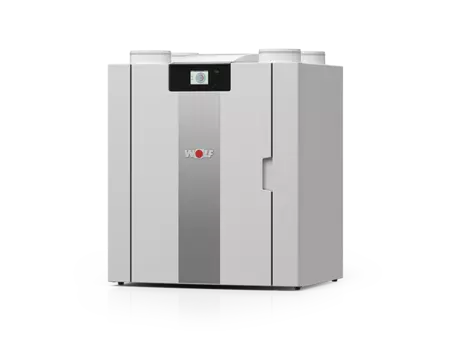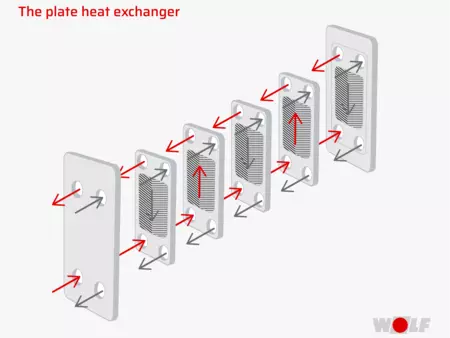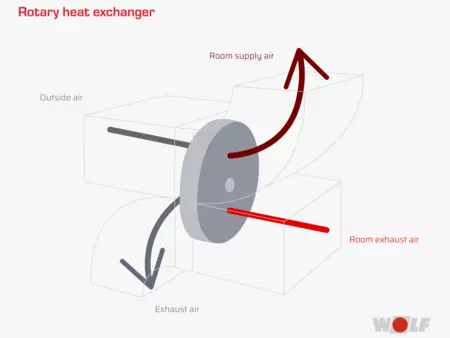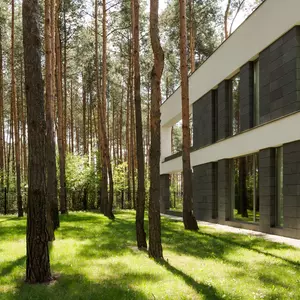
Heat recovery
with controlled mechanical ventilation
Due to the climate crisis, it is more important than ever to continuously reduce CO2 emissions. Accordingly, an increasing number of homes are receiving better insulation. This is good for the climate but bad for the quality of the indoor air. The solution: controlled mechanical ventilation with heat recovery.
Benefits of mechanical ventilation with heat recovery
The current state of building technology offers sealed windows with multiple glazing and exterior walls with good thermal insulation. This applies to new buildings, but is also becoming more and more prevalent in existing buildings as a result of refurbishment.
In terms of energy technology, this is very good – the need for heating energy is reduced considerably as a result. However, a new problem arises. The buildings are then so airtight that an exchange of outside air and inside air is hardly possible.
The result: odours and moisture cannot be transported to the outside. This in turn means that residents open the windows often and for a long time in order to get fresh air into the apartment and to prevent mould growth.
However, a lot of heat is lost in the process. This runs counter to all energy efficiency efforts. The remedy here is controlled mechanical ventilation with heat recovery.
Mechanical ventilation
CWL-2
The most compact in its class, extremely quiet and highly efficient – the new CWL-2 series from WOLF.

Heat recovery with controlled mechanical ventilation
Controlled mechanical ventilation is a mechanical ventilation system that mainly consists of ventilation pipes, two fans, filters and a heat exchanger.
The fan for the exhaust air directs it to the outside via the heat exchanger. The fan for the supply air blows it inwards via the heat exchanger.
In the heat exchanger, the cold supply air is preheated by the warm extract air. This means that the energy required to bring them to room temperature is reduced.
At the same time, the system contains filters that filter out dust and pollen from the supply air. This is a great relief for allergy sufferers.
Decentralised mechanical ventilation with heat recovery
The decentralized ventilation system consists of several devices that are installed directly into the window or facade. This variant is mainly used in existing buildings because you do not have to lay any ventilation tubes.
Heat recovery system
What is a recuperative heat recovery system?
In a recuperative heat recovery system, the two air flows of the exhaust and supply air do not come into direct contact with one another. Instead, they flow past each other through the plates of a plate heat exchanger. In the process, the supply air is heated.

What is a regenerative heat recovery system?
Regenerative heat recovery uses a liquid or solid intermediate medium. The thermal energy of the extract air is temporarily stored in this medium and later absorbed by the supply air. This intermediate storage medium can be a rotary heat exchanger or a static storage mass.

The key terms
If you take a closer look at home ventilation and heat recovery, you will repeatedly come across certain technical terms. The most important names are:
- The heat recovery rate
The heat recovery coefficient is also called the degree of temperature change factor, temperature efficiency coefficient or degree of temperature exchange. This number indicates what proportion of the heat is extracted from the extract air. It is a measure of the efficiency of the heat exchanger used.
- Degree of heat recovery
The degree of heat recovery corresponds to the heat recovery rate of the exhaust air, supplemented by the waste heat from the device. - Heat integration
Heat integration, also known as pinch analysis or Linnhoff analysis, is a method that optimizes the energy consumption of certain processes. The processes of energy supply and heat recovery are optimally coordinated with one another.
Mechanical ventilation in new and old buildings
In existing buildings, controlled mechanical ventilation can only be achieved with a lot structural work. For a central ventilation system, ventilation pipes must be laid through the house. A decentralized system is therefore usually suitable for older buildings. Although this is less efficient, it does not require any major construction work.
In a new building, if you plan in good time, you have all the options. A central ventilation system would be advantageous here, as it works particularly effectively.

Benefits
Less heat loss than with conventional window ventilation
The risk of mould growth decreases as the moisture inside the house is constantly transported away
Odours and pollutants can be extracted through appropriate system planning
Good for allergy sufferers: air filters in the system filter fine dust and pollen from the fresh air
Less noise from outside, as you don’t have to open any windows to ventilate (this is especially advantageous on busy streets)
Conclusion
In the case of new buildings, controlled living space ventilation with heat recovery is now almost mandatory. Due to the high requirements for thermal insulation of the new buildings, there is no longer a sufficient natural exchange of air in these houses
This is not only uncomfortable for the residents, it also leads to the formation of mould in the long term. But a ventilation system can also be useful in existing buildings.


